At first glance Rottefella’s Freedom binding pretty much rocks. It shares the heritage of NTN’s trademark superb control, both in forward resistance and edge hold, although in the case of the Freedom, less is more ‐ meaning a notch less tele-resistänçe gives a wider sweet spot – mo’ betta’ in deep snow.
Depending on the rest of your priorities, it pretty much rocks there as well. Though it isn’t DIN or TUV certified, it does offer a safety release that appears to work pretty well and which might, incidentally save your butt in the backcountry someday but I’ll save the details on that for later. What is bound to be most appealing though is how doggone easy it is to get in and out of.
In tour mode it holds it’s own, and again, it is genetically descended from the Freeride so it isn’t a huge stretch of understanding to recognize it has a bit of resistance in the stride, but you won’t notice much unless you’re out for a big day or the snow is soft and you’re breaking trail. It is far better than a cable (doh!), even than a simple 3-pin, but not frictionless like an O1 or Dynafit. Thankfully, the touring range of motion is now a respectable 50° (add 10° for marketing 😉 ).
The climbing posts are easy to engage too. Lightly spring loaded, two heights of climbing bar lift easy with the lip of a ski pole handle, or push back down.
There are a lot of significant differences between Freedom and Freeride, but the core design of latching to your boot with hooks on a spring loaded plate remains, as does the mode switch, only it works easier than the Freeride does. Rather than moving a block in front of the toe to prevent rotation as the Cobra Free and Freeride do, a block of plastic slides under the toe to prevent it rotating. Clever, and much cleaner.
That’s a lot of good news for telemark skiers. If you’re learning to tele and beginning to venture out-of-bounds this is a great binding. For those who want a great skiing binding with a fast, smooth turn engagement, that tours better than 3-pins, Freedom will be your new tool for planting furrows on yonder slopes. If you’re serious about touring efficiency though, the tour mode would be a handicap in a rando race.
When you dig down deeper, nearly all the gotcha’s in Freedom’s performance are in the touring department and some would argue whether such shortcomings are important. Nonetheless, it wouldn’t be an authentic Dostinator review if there wasn’t something to complain about. 😉
Pages:
- 1
- 2

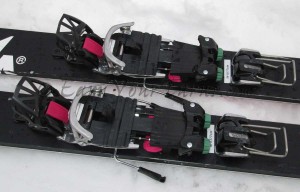
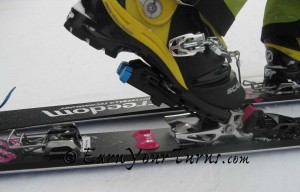
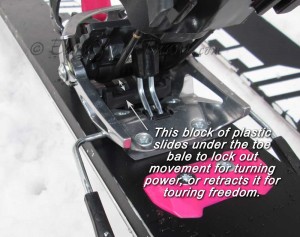
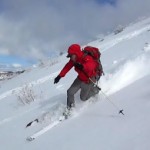
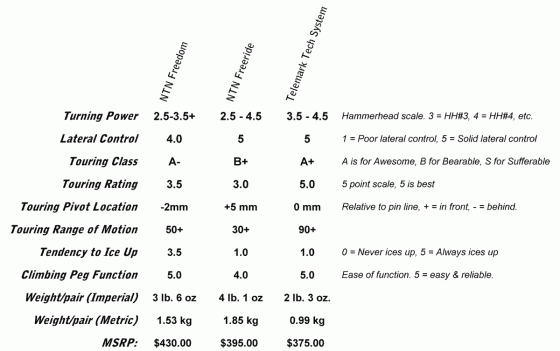
11 comments
10 pings
Skip to comment form
One thought re: icing with the TTS — the tour mechanism doesn’t ice up (anymore than any Dynafit toe), but the space between the Hardwire rods, and the spring cartridges, picks up a ton of snow in the right (read: heavy powder, spring mush) conditions.
I’ve noticed that too. Thought I pointed that out in one of my reviews on TTS, but maybe not. Icing seems to be the common flaw in all touring bindings although I must say, without a doubt the binding with the smallest tendency to ice up, alpine or tele, is Voile’s Switchback.
Recently 2 friends and I (all very experienced telemark skiers) purchased the new NTN Freedoms. Disconcertingly, the threaded bolt holding the toe piece axel has been a problem for all of us. In one case, it loosen enough during the 1st day of use to damage the threads in the pivot bar (axel), requiring a warranty replacement. In my case, on the 4th day of use, the bolt was one turn away from falling out during a backcountry trip – fortunately, I noticed in time to tighten it (although I didn’t have the needed 2 Torx 30 drives). In the third case, it was just loose. All of us have since applied a liberal amount of red locktite. The fact that 3/3 bindings had similar issues suggests this is a common problem. It may be due to poor assembly (there was a only small patch of blue locktite on the bolt, but that obviously didn’t hold). Or perhaps it is a design flaw as the entire axel/bolt rotates when one steps forward in tour mode, and this may cause the bolt to slowly loosen.
Whoa! That’s some serious breakdown. Thanks for the heads up alert!
Having tried the original NTN years ago and not liking the way it felt, I was dubious about the new Freedom. Nonetheless, being that I feel some degree of releasability is essential, I got the new Freedoms. I have to say I’m pleasantly surprised at how well they ski – forward flexing is very consistent, and with minor adjustments to my technique I was loving them, even in powder – the downfall of standard “active” bindings. I will weigh in some more as I log more hours on them.
I’ll look forward to your report. I’m on 1st gen NTNs w/ 2nd gen Crispis and ready to change up. I ski the east and 90% lift-served…and 90% of the time, this is a great set-up. But on those days when it dumps or on my 1 yearly trip out west, they’re more a chore than a dream.
I like how my Freedom’s ski. Not overly active (for my tastes) but very laterally solid. My big complaint so far is that you really have to clean the snow out from under the pivot release lever or it doesn’t successfully latch down.
I would write «télé-résistance» not «tele-resistänçe»… the accents are misplaced… I do not want to sound picky; the article is very interesting…
The switch from ski to skin packs with ice, and won’t fully engage. It then switches back to skin mode while your dropping a knee and stressing the binding. I called rotefella, and they suggest I carry a can of silicone and a wire brush. Kind of a silly response to a design flaw.
These are dangerous bindings, and unreliable in the backcountry.
This flaw was detected very early on and is detailed on page 2 of this review – The Devil’s in the Details.
Yes, I read the whole thing and thought I’d share my experience. Did you know about the ‘engineering fix’, not part of the review? Details indeed.
[…] Posts Review of NTN Freedom Review of NTN […]
[…] and less weight, but for that you’ll have to wait for Rottefella’s touring version (Freedom), available soon, geologically speaking. NTN Freeride 11/12 • $ 395 • 4 lbs. 1 oz. (1.85 kg) […]
[…] that there are four choices, Rottefella’s first NTN binding, the Freeride, now joined by the Freedom which is getting rave reviews for excellent downhill performance and kudos for improved touring […]
[…] pivot is in front of pin line. Not just a little, a full 30mm, no less. It tours better than the NTN Freedom because it has less resistance, but on a long climb it isn’t as efficient as an O1 where the […]
[…] Since penning this article Rottefella has added the Freedom binding to the list of options, so now there are four valid NTN bindings. TTS is maturing. […]
[…] worth noting this flex phenomenon is more problematic with TTS bindings than it is with the NTN Freedom or Freeride […]
[…] using the TTS binding with the cable tension applied at the heel, than it is when using the NTN Freedom with cable tension at the second heel. I think part of that is due to the reverse ramp angle in the […]
[…] Rottefella Freedom […]
[…] allows you a choice of four different bindings to exercise that control – Rottefella’s NTN Freedom, Freeride, or Burnt Mountain Design’s Spike, or the Dynafit inspired Telemark Tech […]
[…] Posts First Look: NTN Freedom (2012) Review: NTN Freedom Review: NTN Freeride (2011) Review: NTN Freeride […]